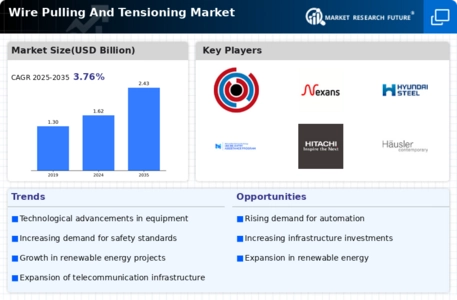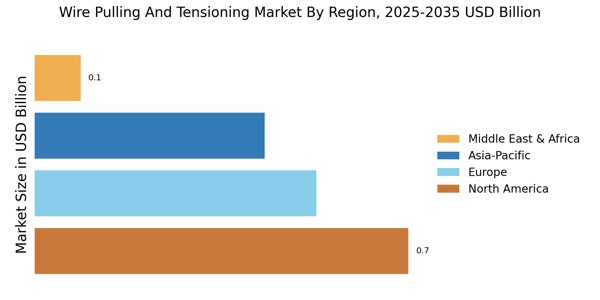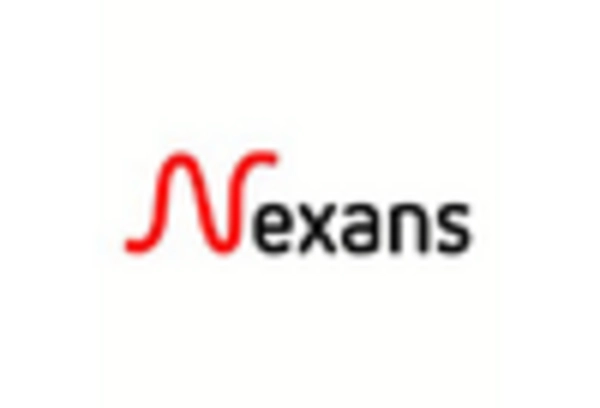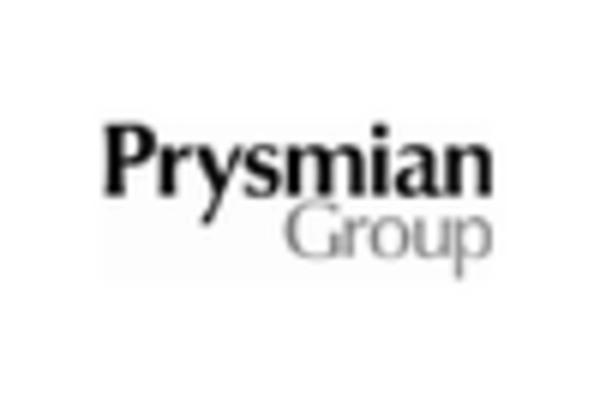Growing Telecommunications Sector
The expansion of the telecommunications sector is a critical driver for the Wire Pulling And Tensioning Market. With the increasing demand for high-speed internet and mobile connectivity, the installation of fiber optic cables and other communication infrastructure is on the rise. This growth necessitates advanced wire pulling and tensioning solutions to ensure the integrity and performance of these systems. Recent statistics reveal that the telecommunications industry is expected to grow by 8% annually, which will likely enhance the demand for specialized wire installation services. As telecommunications companies invest in upgrading their networks, the Wire Pulling And Tensioning Market is positioned to benefit from this upward trend, fostering innovation and competition.
Increased Demand for Renewable Energy Solutions
The Wire Pulling And Tensioning Market is witnessing a surge in demand for renewable energy solutions, particularly in the installation of wind and solar energy systems. As countries strive to meet their renewable energy targets, the need for efficient wire pulling and tensioning methods becomes paramount. The installation of solar panels and wind turbines requires specialized equipment to ensure optimal performance and safety. Recent market analysis indicates that the renewable energy sector is projected to grow by 10% annually, which will likely drive the Wire Pulling And Tensioning Market forward. This trend not only supports environmental goals but also creates opportunities for companies specializing in innovative wire installation techniques.
Rising Urbanization and Infrastructure Development
The ongoing trend of rising urbanization is significantly impacting the Wire Pulling And Tensioning Market. As urban areas expand, the demand for robust infrastructure, including telecommunications and electrical systems, is surging. This growth necessitates efficient wire pulling and tensioning solutions to ensure the reliability of these systems. Recent data suggests that urban infrastructure projects are expected to increase by 7% annually, driving the need for advanced wire pulling technologies. Additionally, government investments in smart city initiatives are further propelling the demand for high-quality wire installation services. Consequently, the Wire Pulling And Tensioning Market is poised for substantial growth as it adapts to the evolving needs of urban environments.
Sustainability Initiatives in Wire Pulling and Tensioning
Sustainability initiatives are becoming increasingly pivotal within the Wire Pulling And Tensioning Market. Companies are now prioritizing eco-friendly materials and practices to reduce their carbon footprint. The shift towards sustainable wire pulling solutions, such as recyclable materials and energy-efficient machinery, is not only beneficial for the environment but also aligns with regulatory requirements. Recent studies indicate that businesses adopting sustainable practices can enhance their market position and appeal to environmentally conscious consumers. This trend is expected to contribute to a growth rate of approximately 5% in the Wire Pulling And Tensioning Market over the next few years. As sustainability becomes a core value for many organizations, the demand for innovative, eco-friendly solutions in wire pulling and tensioning is likely to increase.
Technological Advancements in Wire Pulling and Tensioning
The Wire Pulling And Tensioning Market is experiencing a notable transformation due to rapid technological advancements. Innovations such as automated tensioning systems and advanced wire pulling equipment are enhancing efficiency and safety in operations. For instance, the integration of IoT technology allows for real-time monitoring of tension levels, which minimizes the risk of wire failure. According to recent data, the adoption of these technologies is projected to increase operational efficiency by up to 30%. Furthermore, the development of lightweight materials for wire pulling tools is reducing labor costs and improving ease of use. As these technologies continue to evolve, they are likely to drive significant growth in the Wire Pulling And Tensioning Market, attracting investments and fostering competitive advantages.


















Leave a Comment